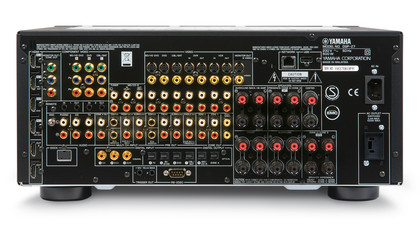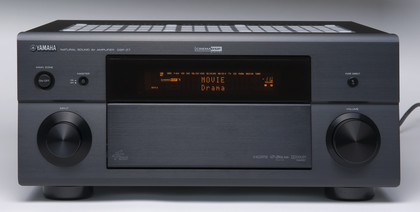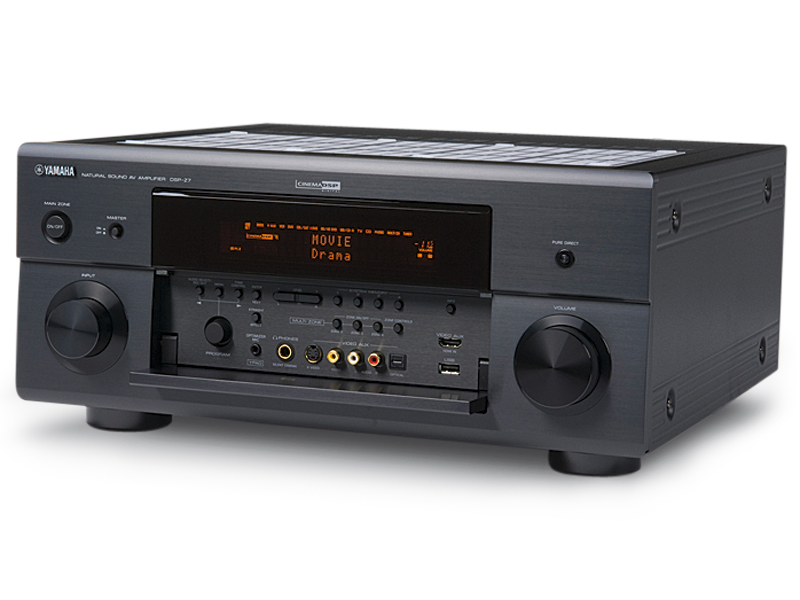TechRadar Verdict
Using parts from it's superb big brother, this amp is excellent value for money
Pros
- +
Fabulously large sound with huge bass and plenty of detail
- +
Easy to use
- +
Great YPAO
Cons
- -
Orange display
- -
Disconcerting pops when changing sources
Why you can trust TechRadar
Yamaha's DSP-Z7 has come to be because the company's flagship DSP-Z11 is just a little too extreme for many. Extreme on the wallet, extreme on the features count, extreme in performance and extreme in its demand for loudspeakers – ideally 11 of them and two subwoofers.
Back in the real world, where UK homes get ever smaller and low-clutter décor is the prevailing fashion, the Z11 remains an awesome niche product at the top of its game. Only the well-heeled (who can have the system discreetly custom installed), or nutters need apply. Yes, I do have one.
Once Yamaha's engineers had recovered from their four-year power-trip creating the Z11, it suddenly seemed like a good idea to make a Z11 'lite'. Say, most of the power, most of the performance, most of the features – only at half the price.
They lopped off the last four channels, lost the THX certification and THX post-processing, cut back on the really esoteric components, slimmed down the power supplies and put everything in a smaller chassis. The result is the much more affordable and very appealing DSP-Z7.
In fact, my blasé description of how the Z7 has been created is not that far from reality. This amplifier offers 7 x 140W as opposed to the Z11's 7 x 140W + 4 x 50W, and almost every feature of its bigger brother and most of the connectivity.
You still get four-zone multiroom, Ethernet networking and Advanced YPAO Room EQ – complete with the whacky mic-support plinth that looks like a tri-lobed boomerang. I did try throwing it – it didn't come back.
The onscreen GUI is also a hand-me-down, still looking pretty cool even if the competition for designer GUIs has become really hot of late. I suspect Philippe Starck and Lawrence Llewellyn-Bowen will have to be called in for the next round of onscreen display makeovers.
Under the hood, there is a swathe of big-name goodies from the likes of Anchor Bay and Burr-Brown, and a comprehensive tick list of must-have features on a two-grand amplifier. HD-audio bitstream decoding? Tick. Dual-output v1.3 HDMI connectivity? Tick. Comprehensive picture adjustment? Tick. Connectivity for iPods (via optional dock) with the ability to display album artwork on screen? Tickety tick.

COMPREHENSIVE: Go on, fill all of these then. We dare you
Yamaha continues to allow you to switch the rear-channel output to its front 'presence' channels if desired. Ironic, then, that the Z7 doesn't yet offer Dolby Pro Logic IIz, which can drive front height channels.
I have now been around long enough for Yamaha's black fascia and orange display cosmetic to come back into fashion – for the second time. Twenty years on and I still don't like it. You can't fault the Z7's robust build and purposeful stance on the rack, though, and the drop-down fascia offers access to almost all functions should you manage to lose both the main and secondary remotes. Setup is fully automated – saving you moving the mic around – and the overall ease-of-use is none too bad at all.
YPAO
Yamaha's Parametric room Acoustic Optimiser (YPAO) has proven to be one of the most effective room EQ systems on the market. The Z7's implementation is no exception, and, after running a simple three-position setup with the supplied boomerang stand, the results were subtle yet impressive.
Gone was a slight room-induced boom around 50Hz, and the dip in the front-right channel – due to the sound disappearing out of my bay window – had been balanced out. YPAO isn't an overt filtering and boosting system that trashes fidelity, but a careful trimming of some problem frequencies to give a sprightly and detailed sound with plenty of punch.
Punch, in fact, is something that the Z7 has by the truck-load. The action sequences throughout the new edition Blu-ray of Terminator 2: Judgement Day explode out of the speakers with pace and power aplenty. The bass effects are massively potent but equally tight and agile.
Gun shots are not just huge great visceral booms but each one is crafted with a complete mechanical symphony of moving metal parts, clattering ammunition and a reverberating thump in your chest. Basically, it feels like you have been shot; the Z7 has ample reserves of power to make things seem like the real deal live event and, given decent speakers, packs a dynamic range that makes most local cinema audio systems sound compressed.
Helped in no small way by T2's awesome DTS-HD MA 6.1 soundtrack, the Z7 turns watching this action-fest into a whole-body experience. It wraps you up in the story with its immersive presence. The soundstage is rendered as a tangible vista, with superb steering around the room, and even tricky outdoor scenes have great space and perfect ambience.
From the top to the bottom of the frequency range the Z7 feels immensely sure-footed and in control. The result is a very solid, very tactile sound that left me ooohing and aaahing at the movie's sonic details.
Subtle sin
Yet the Z7 is not just a beef-cake, it can do subtle as well. With intense material, like the recently-released Blu-ray of Sin City, it proved to be light and agile with superb projection of dialogue. The moody opening scene on the roof top is delivered with all the dark presence of Basin City below.
The subtle car noises, gentle breeze and distant sounds of people, guns and sirens are placed to perfection – painting the scene as accurately as the blistering high-def picture.

FASCIA FACTS: Behind the DSP-Z7's pull-down flap are additional inputs, including USB and HDMI
This receiver's overall stance – natural and detailed sound with a huge low-frequency punch – is right out of the DSP-Z11's list of appealing attributes. Where the Z7 gives way to its bigger brother is at the extreme ends of the audio picture.
The Z11's ability to deliver fine detail, particularly very quiet effects, is absolutely extraordinary whereas the Z7 is simply very good. And in terms of creating the biggest, most impressive, surround sound experience possible in the home, the Z11 is the daddy. The Z7 gets damn close, though.
Inclusion of 'net radio functionality arguably makes the Z7 a receiver rather than an amplifier. The radio is slick to use, although I have seen systems using gateway servers with far more content. Web radio sound is never going to be hi-fi (at present at least) but Yamaha's music enhancer goes a long way to jazzing up the worse offending low bitrate stations.
The Z7's picture tweaking options will be a boon to those with mainstream (rather than high-end) Blu-ray decks and the Anchor bay DVD scaler is a distinct improvement on the chipsets found in budget BD-spinners, TVs and projectors. But do I really miss those extra four channels and esoteric audiophile components? Well, yes I do – but I suspect most people (and their partners) won't find the difference justifies the extra £3K.
At £2,000 the Z7 really is a top-notch performer, packed with features, easy-to-use and offering excellent sound. Okay, it's not exactly a Z11 on the cheap, but offers much of its bigger brother's magic at a fraction of the price. Bargain.
Follow TechRadar Reviews on Twitter: http://twitter.com/techradarreviews
